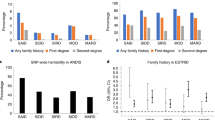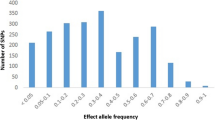Abstract
Aims/hypothesis
We set out to validate a recently reported type 1 diabetes association from the IFIH1 gene variation in an independent cohort from a population of mixed European descent.
Methods
We genotyped five single-nucleotide polymorphisms in the IFIH1 locus, i.e. rs2111485, rs1990760, rs3747517, rs17783344 and rs984971589, in 589 type 1 diabetes nuclear family trios (1,767 individuals).
Results
This study independently replicated the reported genetic association using a family-based approach.
Conclusions/interpretation
The reported type 1 diabetes association is from a linkage disequilibrium region including three candidate genes, i.e. FAP, IFIH1 and GCA. Further variant discovery and fine mapping could help clarify a novel type 1 diabetes mechanism.
Similar content being viewed by others
Introduction
Recently, a large-scale screening of 12,000 non-synonymous single-nucleotide polymorphisms (SNPs) across the human genome [1] found an association between type 1 diabetes and a non-synonymous SNP (Ala946Thr) at the IFIH1 gene, with the evidence coming from both a case–control approach and a family-based approach. IFIH1 is a putative RNA helicase, upregulated by interferons, especially β-interferon [2]. Ifih1-deficient mice are highly susceptible to picornavirus infection, which suggests that IFIH1 is critical for innate antivirus responses [3]. This is of particular interest given evidence for a role of viral infection in type 1 diabetes [4]. In addition to a proven causal link between type 1 diabetes and congenital rubella [5], there is evidence suggesting an association with enterovirus and picornavirus infections [6]. Although the genetic effect size found was relatively small [odds ratio (OR) = 0.85], it suggests a potentially important role of innate immunity and interferon responses in the pathogenesis of type 1 diabetes, which may reveal therapeutic targets. The purpose of the current study was to replicate the genetic finding in an independent, family-based Canadian population sample.
Methods
Participants
In this study, 589 type 1 diabetes nuclear family trios (1,767 individuals) were genotyped. Genomic DNA was obtained after informed consent. The Research Ethics Board of the Montreal Children’s Hospital and other participating centres approved the study. Ethnically, participants were of mixed European descent, with the largest single group being of Quebec French-Canadian origin (40% of total cohort). All patients were diagnosed with type 1 diabetes while younger than 18 years old and had required insulin treatment continuously from the time of diagnosis.
SNP selection
Five SNPs were genotyped in our study [Table 1; Electronic supplementary material (ESM) Fig. 1]. Four of these, i.e. rs2111485, rs1990760, rs3747517 and rs984971, were found to be associated with type 1 diabetes [1], the most significant being rs1990760. The remaining three were in tight linkage disequilibrium (LD) with the condition (r 2 = 0.61–0.92) [1]. The fifth SNP, rs17783344, is flanked by the type 1 diabetes-associated SNPs in this locus (80 kb to the telomeric side of rs3747517 and 16 kb to the centromeric side of rs984971), but was not associated with type 1 diabetes [1]. It is a non-synonymous SNP (Ala80Ser) of the GCA gene and maps to a conserved functional domain (calcium binding). We decided to include it because, according to HapMap data (http://www.hapmap.org/), rs17783344 is common in Europeans but non-polymorphic in East Asians and Africans. This dramatic population differentiation may cause a biased estimation in a case–control study (including false negative results) because of potential population stratification. Our study on the type 1 diabetes association of rs17783344 is immune to population stratification.
Genotyping
Genotypes for this study were obtained using the Sequenom iPLEX assay (Sequenom, Cambridge, MA, USA), which has been described in detail in a previous study [7]. The remaining SNPs in the panel were chosen to replicate some candidate-gene findings. One Mendelian error (0.17%) was found in the genotyping of rs2111485; two Mendelian errors (0.34%) were found in the genotyping of rs1990760. None were found in the genotyping of the other three SNPs.
Statistics
Linkage disequilibrium analyses were performed by Haploview software (http://www.broad.mit.edu/personal/jcbarret/haploview) [8]. Genetic association was tested by the family-based association test software (http://www.biostat.harvard.edu/~fbat/fbat.htm) [9]. Using logistic regression, the OR was estimated based on the transmission disequilibrium test and the UNPHASED software package (http://www.mrc-bsu.cam.ac.uk/personal/frank/software/unphased/) [10].
Results and discussion
The family-based association test in our study is shown in Table 2. The four SNPs reported to be associated with type 1 diabetes, i.e. rs2111485, rs1990760, rs3747517 and rs984971, showed a trend of association with type 1 diabetes in the same direction as previously reported [1]. Two SNPs, rs2111485 and rs984971, have replicable type 1 diabetes association in our dataset, with statistical significance at α = 0.05. The lack of statistical significance of the other two SNPs, rs1990760 and rs3747517, may be due to the lack of statistical power, which is ~61% for rs1990760 with OR = 0.85 at α = 0.05 level and ∼49% for rs3747517 with OR = 0.86 at α = 0.05 level. No association was found for the non-synonymous SNP rs17783344 from the GCA gene.
The type 1 diabetes-associated SNPs, rs2111485 and rs984971, locate in a LD block containing four genes: FAP, IFIH1, GCA and KCNH7 (ESM Fig. 2). The FAP gene product has been identified as a human stromal antigen, which can stimulate cytotoxic T cell responses [11]. The GCA gene product is abundant in neutrophils and macrophages, and is associated with degranulation and consequent immune reaction [12]. Beside the antivirus-related type 1 diabetes mechanism of IFIH1, FAP and GCA may participate in the autoimmune or inflammatory destruction of pancreatic beta cells. Therefore, all of these three genes are candidates for type 1 diabetes. However, further variant discovery and fine mapping are required to confirm that the IFIH1 SNP is actually causative. Because of the tight LD and the small effect size of type 1 diabetes association, this may not be easy. However, if the antivirus-related genetic effect exists, an association between the SNPs and enterovirus infection could be found by a case–control study of host susceptibility. Moreover, if an autoimmune effect were found to exist, association between the SNPs and other cytotoxic autoimmune diseases could be expected, bearing in mind that other autoimmune diseases could also be associated with virus infection. A combined genetic effect of these genes, i.e. antivirus-associated effect and cytotoxic autoimmune reactions, is possible.
Abbreviations
- LD:
-
linkage disequilibrium
- OR:
-
odds ratio
- SNP:
-
single-nucleotide polymorphism
References
Smyth DJ, Cooper JD, Bailey R et al (2006) A genome-wide association study of nonsynonymous SNPs identifies a type 1 diabetes locus in the interferon-induced helicase (IFIH1) region. Nat Genet 38:617–619
Kang DC, Gopalkrishnan RV, Wu Q, Jankowsky E, Pyle AM, Fisher PB (2002) mda-5: An interferon-inducible putative RNA helicase with double-stranded RNA-dependent ATPase activity and melanoma growth-suppressive properties. Proc Natl Acad Sci U S A 99:637–642
Kato H, Takeuchi O, Sato S et al (2006) Differential roles of MDA5 and RIG-I helicases in the recognition of RNA viruses. Nature 441:101–105
van der Werf N, Kroese FG, Rozing J, Hillebrands JL (2007) Viral infections as potential triggers of type 1 diabetes. Diabetes Metab Res Rev 23:169–183
Menser MA, Forrest JM, Bransby RD (1978) Rubella infection and diabetes mellitus. Lancet 1:57–60
Haverkos HW, Battula N, Drotman DP, Rennert OM (2003) Enteroviruses and type 1 diabetes mellitus. Biomed Pharmacother 57:379–385
Qu H-Q, Marchand L, Grabs R, Polychronakos C (2007) The IRF5 polymorphism in type 1 diabetes. J Med Genet 44:670–672
Barrett JC, Fry B, Maller J, Daly MJ (2005) Haploview: analysis and visualization of LD and haplotype maps. Bioinformatics 21:263–265
Horvath S, Xu X, Laird NM (2001) The family based association test method: strategies for studying general genotype–phenotype associations. Eur J Hum Genet 9:301–306
Dudbridge F (2003) Pedigree disequilibrium tests for multilocus haplotypes. Genet Epidemiol 25:115–121
Fassnacht M, Lee J, Milazzo C et al (2005) Induction of CD4(+) and CD8(+) T-cell responses to the human stromal antigen, fibroblast activation protein: implication for cancer immunotherapy. Clin Cancer Res 11:5566–5571
Boyhan A, Casimir CM, French JK, Teahan CG, Segal AW (1992) Molecular cloning and characterization of grancalcin, a novel EF-hand calcium-binding protein abundant in neutrophils and monocytes. J Biol Chem 267:2928–2933
Acknowledgements
This work was funded by the Juvenile Diabetes Research Foundation International and Genome Canada. H.-Q. Qu is supported by a fellowship from the Canadian Institutes of Health Research.
Duality of interest
The authors declare that there is no duality of interest associated with this manuscript.
Author information
Authors and Affiliations
Corresponding author
Electronic supplementary material
Below is the link to the electronic supplementary material.
ESM Fig. 1
The LD map of the IFIH1 SNPs based on our genotyping data. The haplotype map was made by Haploview version 3.2 software (http://www.broad.mit.edu/personal/jcbarret/haploview). The r 2 values (%) are shown in the boxes. The red colour depth represents the D′ values (PDF 16.1 KB)
ESM Fig. 2
The LD map of common SNPs (minor allele frequency >0.05) around the IFIH1 locus based on the HapMap data produced by Haploview version 3.2 software (http://www.broad.mit.edu/personal/jcbarret/haploview). The r 2 values (%) are shown in the boxes. The red colour depth represents the D′ values, while the blue squares have D′ = 1 and LOD<2. Two red arrows point to the type 1 diabetes-associated SNPs, rs2111485 and rs984971. Four genes have been located in this region, namely FAP, IFIH1, GCA, and KCNH7 (PDF 104 KB)
Rights and permissions
About this article
Cite this article
Qu, HQ., Marchand, L., Grabs, R. et al. The association between the IFIH1 locus and type 1 diabetes. Diabetologia 51, 473–475 (2008). https://doi.org/10.1007/s00125-007-0895-6
Received:
Accepted:
Published:
Issue Date:
DOI: https://doi.org/10.1007/s00125-007-0895-6




